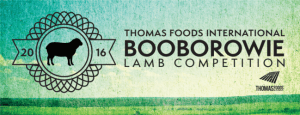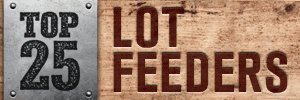 BOOBOROWIE is a small town in South Australia with some lamb producers and community members who are thinking big.
BOOBOROWIE is a small town in South Australia with some lamb producers and community members who are thinking big.
The Booborowie locals led by former Thomas Foods International sales manager Leith Tilley are organising the inaugural and unique Booborowie Lamb Competition, starting next month with total prizemoney of $7500.
Modelling it on the huge Ekka feedlot weight gain competition for beef cattle, they aim to make their initiative the most lucrative lamb feeding competition in Australia and a major fund-raiser for the community and local school.
Competition organiser Leith Tilley said the competition is different and more of a competition to reward the growth in lamb value in the feedlot rather than carcase quality traits alone, with commercial return the main part of assessment.
The teams of three lambs will be fed at Saltbush Ag’s feedlot at Booborowie starting in late February and finishing in April. Prizes will be awarded for the best commercial Merino/SAMM/Dohne team, best commercial crossbred team and best stud.
“The main aim is to help raise funds for the Booborowie community and school – but also to run an information and networking opportunity for farmers centred around a lamb feeding competition.
“Our long term aim is to make this the most lucrative lamb feeding competition in Australia – the lamb version of the beef carcase competition run by the Ekka which has $46,000 in prize money this year,” Mr Tilley said.
Competition has received broad commercial support
Major meat processor Thomas Foods International is on board as a naming sponsor with Landmark and CRT as major prize sponsors and Sheep Central joining as a media sponsor.
Mr Tilley said lamb teams will be judged on their aggregate percentage weight gain in the feedlot.
“We are trying to find the team with the greatest percentage growth.”
He expected producers to relate their results back to sire bloodlines, pre-feedlot ewe and lamb, and general farm management. Mr Tilley said he would support the competition with two teams to compare his Merino and crossbred lambs.
“It is just to give the farmers another tool to benchmark how they are going for farm management, genetics and lamb finishing.”
As the competition develops, MSA lamb parameters such lean meat yield, intramuscular fat and eating quality could be incorporated into the judging criteria.
The competition can handle up to 80 teams of three lambs and will accept interstate entries, Mr Tilley said.
“It is limited to 240 lambs, which is basically one pen at the feedlot – next year we can go bigger.”
Booborowie competition overview
The competition is based on benchmarking teams of lambs supplied by producers through a single feeding program at a local lamb feedlot.
The competition will be separated into Merinos/SAMMs/Dohnes and crossbred. A team is to be made up of 3 Merino/SAMM/Dohne or 3 crossbred lambs. A farmer can enter more than 1 team – for example 1 team of Merinos and 1 team of crossbred lambs or 2 teams of Merinos.
All lambs must meet the minimum standards set by the organizers – for example must be less than 20mm skin, ideally over 35kg liveweight, good health/condition, etc….. These standards will be agreed to with the feedlot and publicised closer to the date.
All teams are to be delivered to the feedlot on a set date and will be curfew for 24 hours prior to the entry weighing.
All lambs will be tagged with an electronic tag and recorded in their teams by the feedlot on arrival.
Farmers are invited for the entry weighing day and a price per head will be set based on their liveweight (note: no skin values will be used). The liveweight price will be set by agents/Thomas Foods International to reflect the current prices for merinos and cross breeds. This price is the “Store Lamb Price” and each farmer will be paid this for their lambs at the completion of the event.
Lambs will be treated as per the normal feedlot entry procedures. Lambs will then be feed together as 1 line in the feedlot to ensure consistency. The lambs will go through an induction program under the control of the feedlot management. Lambs will then be fed for 45-60 days (to be determined through consultation with the buyers and feedlot management).
Lambs maybe weighed through the feeding process and farmers will receive any updated data accordingly.
The feedlot will charge a fixed daily rate – this is “Feeding Cost”. Lambs will all be slaughtered together and data collected based on NLIS tags. Lambs will be sold at a fixed rate over the hooks (c/kg) with different prices for Merino/SAMM/Dohne and crossbred lambs to reflect the current market prices. Skin values will be separated for Merino/SAMM/Dohne and crossbred lambs to reflect the current market prices. The hooks and skins prices are combined for each team and called the “Lamb Carcase Return”.
The farmers are then benchmarked based on the average percentage increase from Lamb Carcase Return compared with the Store Lamb Price. The below table highlights how this works:
| Lamb 1 | Lamb 2 | Lamb 3 | Average | |
| Entry weight (live) | 35 | 38 | 42 | |
| Price | 2.20 | 2.20 | 2.20 | |
| Store Lamb Price | 77.00 | 83.60 | 92.40 | 84.33 |
| Carcase Weight | 22.60 | 23.50 | 25.20 | |
| Carcase Price | 5.20 | 5.20 | 5.20 | |
| Carcase Return | 117.52 | 122.20 | 131.04 | |
| Skin | 5.00 | 5.00 | 5.00 | |
| Lamb Carcase Return | 122.52 | 127.20 | 136.04 | 128.57 |
| Percentage Increase | 52.4% |
The feeding cost is not used to calculate the benchmark as it will distort the results based on the weight of the animals (i.e. larger animals will eat more than smaller animals) and we are unable to determine exactly how much feed is used per animal.
In the case of a lamb death or if the feedlot management determine that a lamb is not performing due to illness or other issues, then they will be removed from the competition and not affect the average of the remaining lambs in the team. If an animal is to be removed from the competition the feedlot management will decided whether to continue feeding or remove completely and discuss with the farmer on what action to take.
At the completion of the event, the farmers will be paid the “Store Lamb Price” and the feedlot will be paid the total “Feeding Cost”. The Booborowie community will use the margin from the lamb carcase return, less feeding cost and store lamb costs to support the local Booborowie School and community.
Click here to access an entry form.
For further information and to enter the competition contact Leith Tilley on 0417783668 or [email protected]



HAVE YOUR SAY